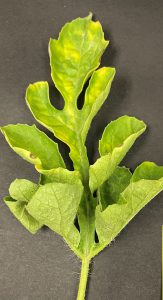IMMOKALEE, Fla. — Florida watermelon growers, the most productive in the nation, face two new viruses. But finding a disease is the first step to managing it, says a University of Florida scientist who helped pinpoint the diseases.
From 2017-2020, Florida was the No. 1 state in watermelon production, according to the U.S. Department of Agriculture – National Agricultural Statistics Service. In fact, in 2020, Florida produced more than 850 million pounds of watermelon.
That high yield makes it crucial for growers to stay abreast of new diseases. That way, they can better protect their crop. UF/IFAS plant pathology professor Pamela Roberts helped find the new viruses afflicting this member of the gourd family, or a cucurbit.
Now that they’re aware of the viruses, growers can find ways to deal with the diseases.
“Now that it is known that there are additional (watermelon) viruses in the mix, efforts can be made to determine their impacts and how to manage them,” Roberts said. “The viruses very likely occur in mixed infections, with the other viruses already present in Florida and other watermelon-producing states.”
In the new paper, Roberts, a faculty member at the Southwest Florida Research and Education Center, writes that she and her research colleagues found watermelon crinkle leaf-associated virus 1 and 2 in Charlotte, DeSoto, Glades, Osceola and Seminole counties.

“There is always concern when there is a new pathogen detected and the potential implications it can have on the crop,” Roberts said. “Unfortunately, so little is known about these viruses that we cannot predict anything about them.”
“We do have evidence that it has been in watermelon for the last two seasons, and we found it because it looked like other virus symptoms,” she said. “But not any of the other viruses were found associated with the viral-like symptoms. So, if it were going to be highly impactful, we might have noticed something different in the field. This also gives an answer as to why we were not detecting the known viruses in obviously symptomatic plants.”
Roberts first learned of the potential of the new virus coming to Florida after hearing a report about it from Texas. She started talking to a plant pathologist at Texas A&M University, and he sent photos. That’s when she decided to test watermelons in Florida for the virus.
For now, until more information is available regarding these viruses — including their vector — UF/IFAS researchers recommend growers continue using their current programs to control insects in their crop.
Growers who suspect they might have watermelon crinkle leaf-associate virus 1 and 2 can bring leaf samples to the plant diagnostic lab at the Southwest Florida REC and to the lab at the North Florida Research and Education Center in Quincy.
-30-
The mission of the University of Florida Institute of Food and Agricultural Sciences (UF/IFAS) is to develop knowledge relevant to agricultural, human and natural resources and to make that knowledge available to sustain and enhance the quality of human life. With more than a dozen research facilities, 67 county Extension offices, and award-winning students and faculty in the UF College of Agricultural and Life Sciences, UF/IFAS brings science-based solutions to the state’s agricultural and natural resources industries, and all Florida residents.
 0
0
